Route of Rocks
Lush beech forests, vertical cliffs and legendary caves
Lush beech forests, vertical cliffs and legendary caves

The majestic natural space that surrounds Anguiano, the gateway to the Najerilla River from the mountain range to the wide Ebro Valley, is the setting chosen by the Route of Rocks to tour the cliffs and mountains that surround the town of Anguiano. A route of great scenic and natural value that will also transport us through the history and traditions that these lands treasure.

The route, with 14.8 km, starts in the Mediavilla neighbourhood, choosing the base of the colossal cliffs that cross the Najerilla River as the best starting point for this walk. We say goodbye to Anguiano for now without resisting to lean out of the deep gorge that the river has formed over the years, a gorge saved by the vertiginous Mother of God Bridge through which we will return. We go, first by road and then by a wide track, to the encounter of the hermitage of La Magdalena, of the 18th century, that at the foot of another colossal cliff keeps next to it its curious intermittent source, whose capricious flow appears and disappears at will. From here, having already said goodbye to the chapel and the Route of Roñas that accompanied us on our journey, we undertake a laborious ascent following the course of the ravine that stretches out before us. When the time comes, we will leave this ravine and, cutting through the mountain, head through a stone quarry to the Las Sillas Pass. A route that will allow us to enjoy the height gained, not without effort. On the other side of the mountain, the Aidillo beech forest awaits us, which we cross in search of the La Tejera Pass, but not before joining the GR 93, the Route of the Serradero and again the Route of Roñas. But this union will not last long, since as soon as we arrive at La Tejera we will separate from them to start the long descent that will take us back to Anguiano.
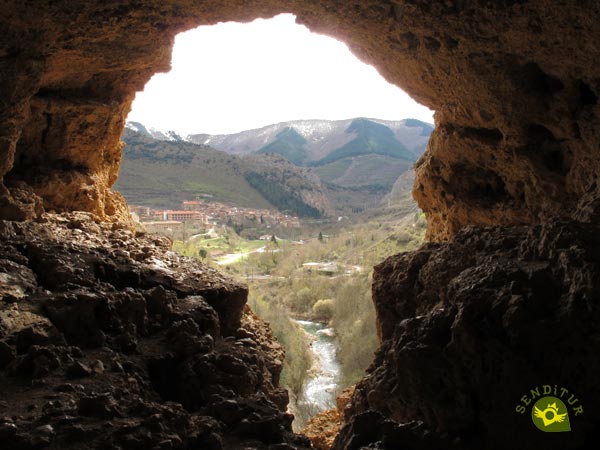
A descent that will take us through the valley formed by the Regatillo stream in its eagerness to join the Najerilla river. This section offers us a pleasant walk, first through the beech forest and then surrounded by cliffs and rocks. Once again, the Route of the Serradero joins us to walk together through the Miraflores corrals and approach, step by step, the town, observed on the other side of the stream by the impressive rocky conglomerates that house Mori Cave. Once in Anguiano, those who wish to do so may enter the town by crossing the Carmen Arch and following the Route of the Serradero in its last meters, putting an end to its journey. If we continue with the march, we will cross the bridge that saves the Regatillo and approaching without more delay until the main road of access to the locality, we will find the continuation of this route. After saving the Najerilla River and passing by the hydroelectric power station located on its bank, we will reach the legendary Nuño Cave, also known as Trombalos. From here we will set a course for the slopes of Clock Rock, where we will once again find the GR 93 arriving from Matute. Separated from the GR, we continue up the mountain to save the Valderraso ravine and set a course, amidst magnificent views, to the Marimatea ravine, where we will join the Route of Three Villas and together we will ascend to the nearby Ayanatón Meadows, following the old Petroleum trail.

Having already said goodbye to the Clock Rock and the Route of Three Villas, from Ayanatón we will set out for another of the great treasures that these places hold. With the Najerilla valley at our feet, we will begin a rapid descent that will take us to the Fountains Ravine, where the Chestnut Tree of the Nisia awaits us, or rather the short detour that will bring us closer to this unique tree of La Rioja that is more than 400 years old. From here we only have to make a comfortable descent to Anguiano through the Caves Neighbourhood. We will pass by the church of San Pedro, dating from the 15th and 16th centuries, and then cross the 18th century Mother of God Bridge to reach the Mediavilla Neighbourhood in Anguiano, which was the start of this hiking route.
Legend has it that there is such a connection between the caves of Nuño and Mori that even though the distance separating them is great, as if by magic, it is possible to hear in one of the caves what one person is talking about in the other, without the latter raising his voice too much.
The municipality of Anguiano is reached by following the LR-113 that links Nájera with the Burgos town of Salas de los Infantes. This same road, in Nájera, connects with the A-12, Autovía del Camino and with the N-120, between Burgos and Logroño. There is also an extensive schedule of intercity buses that connect Anguiano with both Nájera and Logroño. Once there, on the road that crosses the town, at the exit of Anguiano towards Monasterio de Valvanera, we will find a parking area where we can leave our vehicle.
This is a demanding route due to the slope to be covered and the distance, although the route will delight our friend. Pay attention to the short stretch of road and the exposed areas of Nuño Cave and the rocky areas that the route crosses.
Water and food for our companion cannot be missed on this trekking route, although we will find some water points on its route, we cannot leave its hydration to chance.
To the local fauna we have to add the cattle that surely we will find along the route and some that another mascot, that will leave to our encounter to the passage by Anguiano.
The Route of Rocks begins next to the information panels of the Routes between Beech Forests that we have located in the parking that is in the highway that crosses Anguiano (0h 00min), just to the exit of the locality as we went towards the Monastery of Valvanera.

It is this road that we must follow for the moment, leaving on our right the street that leads to the impressive bridge of Mother of God, where we will return at the end of the route.
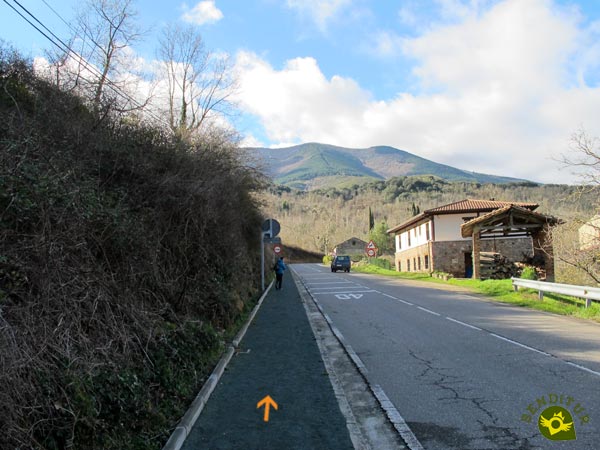
We begin a gentle ascent following the road that will take us out of Anguiano definitively. In this first section of the itinerary we coincide with the itinerary of the Route of Roñas, also included in the Routes between Beech Forests.

We quickly arrive at the crossroads where we must leave the asphalt to continue along the track that will lead us to our first objective of the day.

The slope, without being too noticeable, still does not give us a moment's pause. Our track, which we must not abandon at any time, goes up the course of the Magdalena stream.
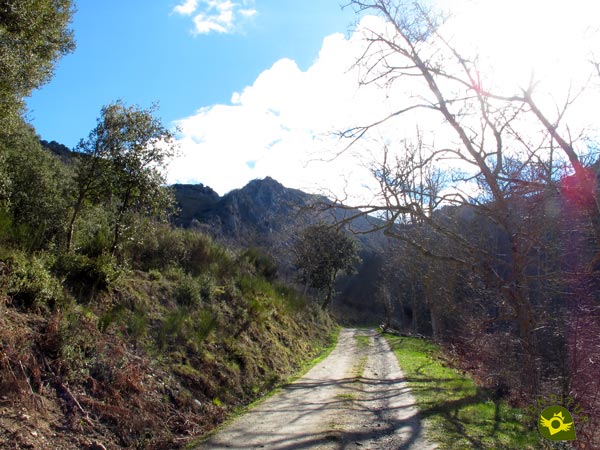
Soon we began to see the steep cliffs we were heading towards. The hermitage of La Magdalena (0h 25min) emerges before us, waiting for us at the foot of one of these vertical rocks.

Just before our arrival at the hermitage we leave the track on the right where the Route of Roñas continues, which at this point bids us farewell.

After the well-deserved visit to the chapel and the famous intermittent fountain, we return to the track that brought us here and which continues its upward course around the building we have just visited.

Soon we leave behind the hermitage and the recreation area next to it to continue climbing up the, for now, wide ravine we are walking through. Here we come to the highly recommended detour that leads to the Peña Portillo viewpoint.

The track begins to blur through the vegetation that covers it until it becomes a mountain trail through which we continue the route.
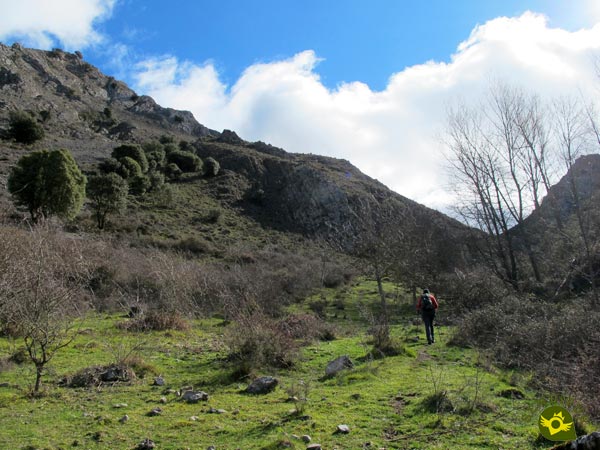
The slope is becoming more demanding almost at the same time as the hillside of the rocks is getting closer, making the route somewhat steeper and more beautiful.

The footpath continues its tireless ascent through the ravine leaving behind the few paths that come out of it. We continue to gain height as our trail appears and disappears covered by the vegetation that grows along this stretch.

A little while later, to our left, the typical stony field emerges from the mountainside, which we seem to have got rid of for the time being. A few meters above, we will be able to see the trail that crosses this field, towards the beginning of which we are heading.

As we had already guessed, the route reaches this trail and turns in a round fashion to lead us across the stony hillside of the mountain.

We continued to cut through the hillside, crossing the tinderbox we had seen on our way up. The slope gave us a break and our exposed path continued to cut through the mountain.

We return to contemplate the hermitage, which is already very low, while we head towards the green pass that precedes the peak under which it is located.
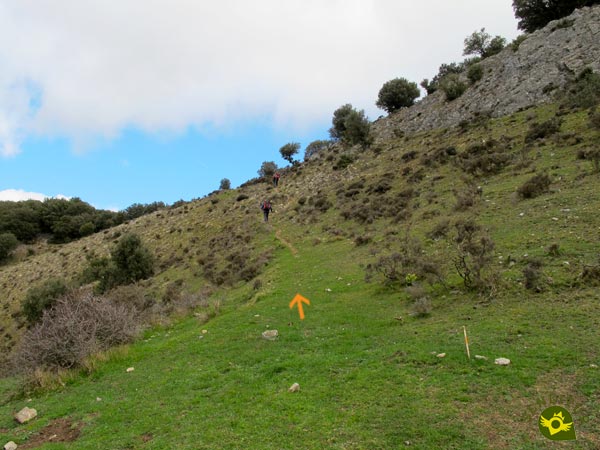
When we reach this pass the route crosses it, we turn to our right to look for the trail that goes up to another nearby pass. We face a new steep slope that quickly climbs up to the mountain range where we will change sides.

As soon as you reach the pass, the route enters the leafy beech forest that populates this hillside. A relatively long stretch awaits us under the protection of the trees following the, generally and depending on the time of year, muddy trail that runs through this beech forest.
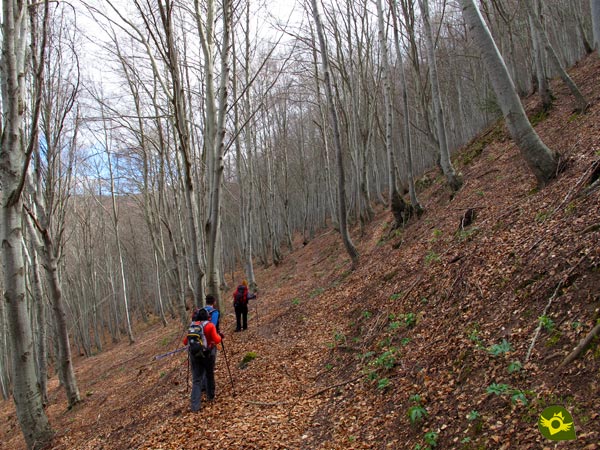
The route continues to cross the hillside, alternating small ups and downs that do not require much effort. The roots of the trees, the leaf litter that practically covers the whole route and the humidity that the shady forest preserves forces us to walk carefully to avoid slips or falls.

Shortly afterwards, on our left, we are joined by the GR 93 route which, together with the Route of the Serradero, goes up from Anguiano through the beech forest, while we meet again the Route of Roñas which, on its way back to Anguiano, goes down following the itinerary of these other routes.

Together we go through the last stretch of this area of the forest. The beech forest gives way to a wide clearing known as La Tejera (1h 20min).
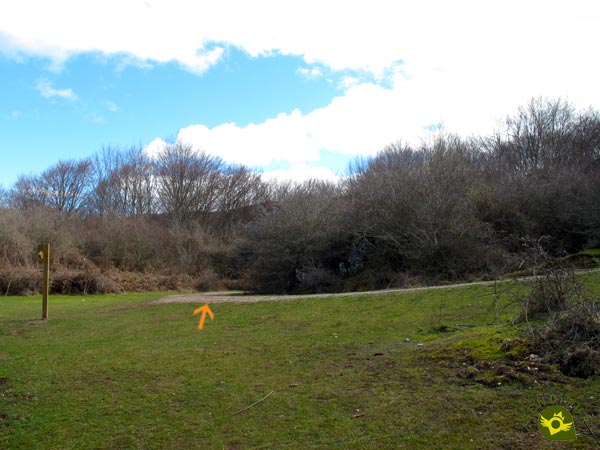
Once we arrive at this crossroads, we must say goodbye to the three routes that accompanied us up to here, as their course continues up the track that we must follow but in the opposite direction.
A long stretch of perfect track awaits us, which will take us to the gates of Anguiano without major complications.

Once again we see ourselves walking through a lush forest as we descend, leaving La Tejera behind us.

A little further on, in the middle of a bend, the Serradero Route joins us and together we continue towards Anguiano.

The track winds through the mountain saving small streams of water that fall down the valley. At none of the few crosses we encounter we must leave our track that continues to take us through the beech forest.

Almost without realizing it, the forest has been giving way and soon we will find ourselves following the descending course of the Regatillo stream without the protection of the shade of the trees.

The absence of the shady forest allows us to contemplate the cliffs and rocks that surround us. Embedded in the valley formed by the tireless stream, we continue the descent following the wide track at all times.

There are not many crossroads or paths that we come across, but in all of them the right path to follow is totally clear.

On our right we come to another of the detours that tempt us on this route, the one that leads to the Viewpoint of the Windows.

Little by little we are leaving the valley and we can already sense the rocks that surround Anguiano and its first buildings.

We leave on our left the path that leads to the repeater to go down the final stretch of the track to the entrance of Anguiano (2h 30min).

Here we will definitely say goodbye to the Route of the Serradero and we will also have the possibility of ending our route by entering the town to go to the parking lot from which we are separated by approximately 1 km.
Those who do not want to leave the other side of the Route of Rocks for another day should continue on their right, leaving behind the entrance to Anguiano and following the old road that reached the town.

This road is in charge of guiding us in this stretch of the route, crossing the stream that brought us here.

After a small steep slope we can already see the main road towards which we are heading.

When we reach it, we will follow its course towards Anguiano for a few meters in search of the track where our route continues.

In the middle of the curve, the track we were looking for emerges and descends towards the Najerilla River. After crossing the river, we headed for the nearby power station.

The fence that delimits this complex is in charge of showing the way to follow. We ascend following a stony path that leads us back to Anguiano.
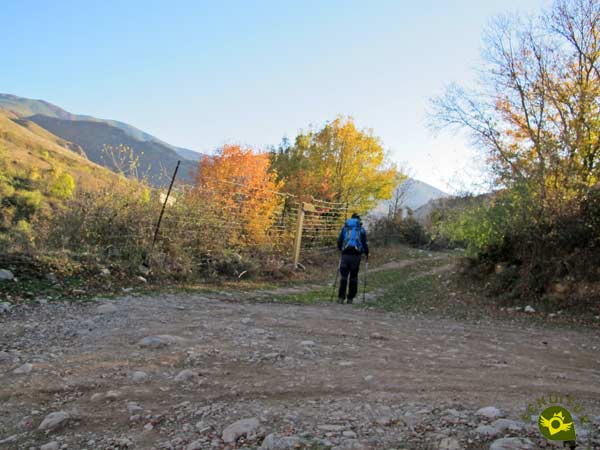
In the middle of the bend we come to a very advisable detour that takes us to Nuño Cave.

We leave the path to which we will return after the visit to this magnificent cave to quickly, almost following the power line, leave the path we were on and head across country towards the wooded area that covers the mountainside.

When we reach its limits we will find the path that we have to follow, ascending and going into the vegetation.
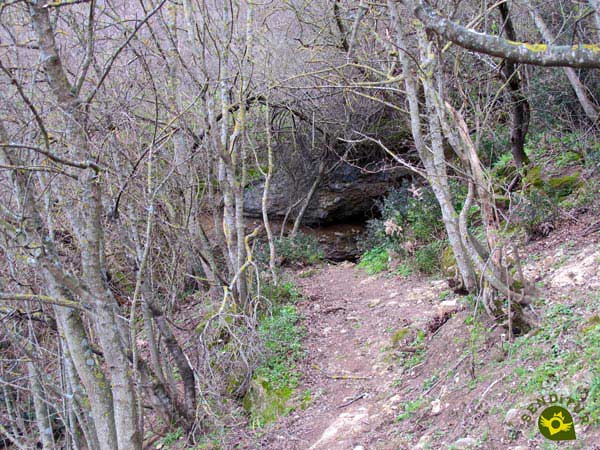
Almost immediately, before us, a small cave opens up, practically hidden by the vegetation, which we approach as it is the entrance to Nuño Cave (2h 55min).

Although it might appear to be a simple cavity drilled in the mountain wall, we soon realise, as we enter it, that it extends to the opposite wall, where it offers us magnificent views, worthy of a short break on our route.
Once we had enjoyed this spectacular place, we retraced our steps to resume the route we had abandoned before.

The path takes us to an animal farm, which we will border following the route markings.
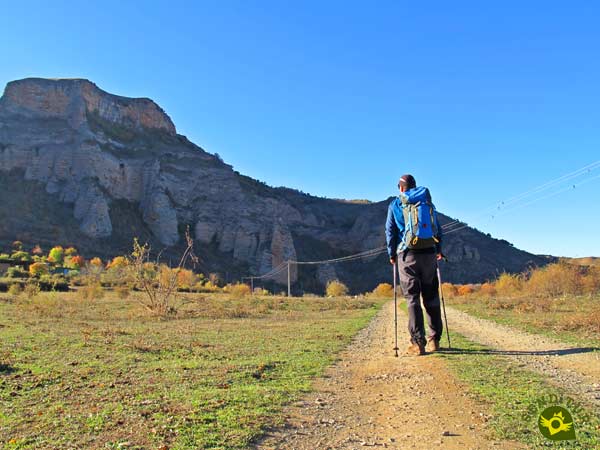
We leave the farm behind to go through a metal gate and begin a gentle ascent that takes us to the GR 93.

When we reach them, we are forced to radically change course to return towards Anguiano.

This part of the route climbs along the same route as the GR 93 without turning off at any of the crossroads we come across.

After a while we reach the end of this uphill section, at which point we say goodbye to the GR 93, which continues its course towards Anguiano.

We leave behind us the GR 93, which starts a vertiginous descent while we continue to climb the shoulder of the mountain in search of the upper part of the ravine through which the GR descends.

The slope, which is much less demanding than what was previously overcome, continues to test energies that are already low at this point. The path we follow, well defined, brings us closer to the base of Clock Rock.

Further on our path is divided into several options, we will head towards the end of the ravine leaving on our right the paths that ascend to the base of the rock.

The route leads us to a large rock leaving Clock Rock on our right. The route borders this rock, crossing the ravine.

After saving a small slope we will meet on the other side of the ravine observing the road travelled to get here.

Our trail, clearly more marked than the rest, together with the signs of the route, make it very clear which way to go in case of doubt.
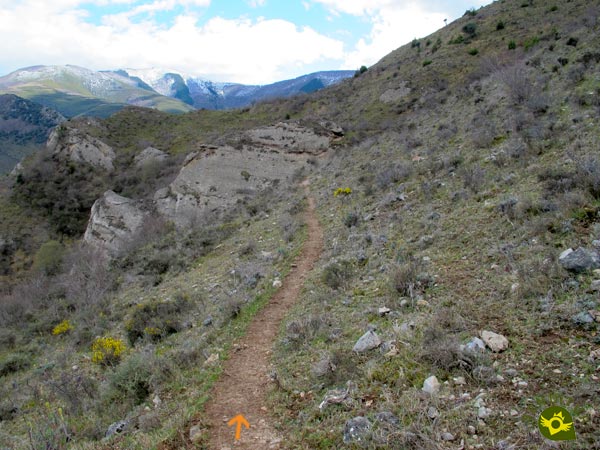
We cut the slope of the mountain leaving behind the wide ravine we have just crossed. This area allows us to enjoy magnificent views of the Najerilla Valley and the surrounding rocks.

The trail leads us to a hill where one of the posts of the route marks the moment to change course and climb the short slope that separates us to reach the Marimatea Ravine (3h 45min) where we will join the Route of Three Villas.

Here we have a new opportunity to return to Anguiano following the Route of Three Villas, or to go up its course, following the track by which it arrives, to continue with the route that we are carrying out.

The path makes us gain altitude relatively quickly as it zigzags up the mountain. Once again the route asks us to make another effort to overcome the slope that separates us from the meadows we are heading towards.
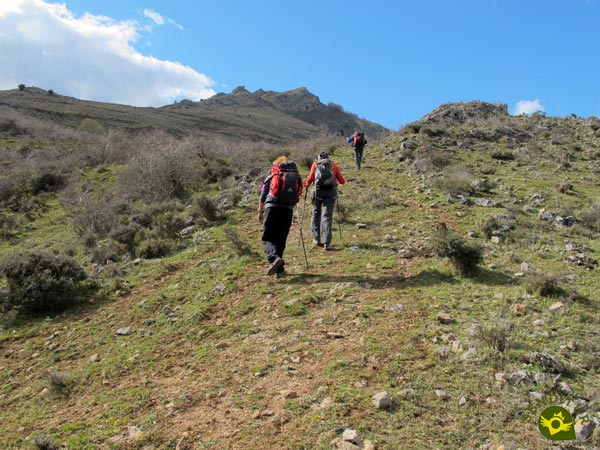
The slope is losing intensity as we approach the Ayanatón Meadows (4h 05min). Once again we are at another crossroads where we will say goodbye to the Route of Three Villas to continue our journey.

Our route turns radically, turning to face the Najerilla Valley, now hidden from our gaze. Luckily, except for some short and soft slopes, from now on, we will only have a long descent that will take us to Anguiano.

The trail, halfway up the hillside, offers us spectacular views again as we go along. Once again, the best state of the trail to follow serves as a reference in case of doubt.

Soon we reach another pass where our trail again blurs under the grass that covers the ground. If we advance a few metres across the hill, we will soon see the post that marks the continuation of the footpath that begins a gentle descent.

We continue with the Najerilla valley on our left, heading towards another mountain ridge. When we reach this new mountainous shoulder, the vertiginous descent that we have ahead of us begins.

The trail zigzags at first letting us see its layout. We quickly lose height as we approach a somewhat stony area.

We reach the apex of the ravine, at which point our trail changes direction again to follow the course of the ravine that looks for the nearby Najerilla Valley.

After crossing a couple of small streams, the ravine gains in width while we continue to lose height with each step.

An information post indicates that we are on the detour that, if followed, would take us to the nearby Chestnut Tree of the Nisia (4h 25min), just 100m from this junction.
Once we have visited the Chestnut Tree of the Nisia, where shortly before arriving we will find a path that if followed would take us to the encounter of the Route of Three Villas, we will resume the descent that still remains ahead of us.
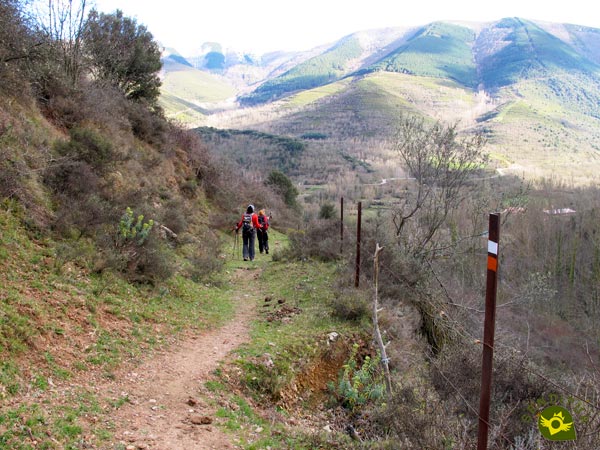
The trail, which is marked out by a metal fence, brings us little by little closer to our final destination, which we can already see in front of us.

We will have to go through another wooden gate, which stops the animals, to continue our descent.

Soon the stony trail leads us to the very entrance to the town. The first houses of Anguiano will guide us through its streets.

Once again, we come across the Route of Three Villas which, on our right, seeks to leave the town.
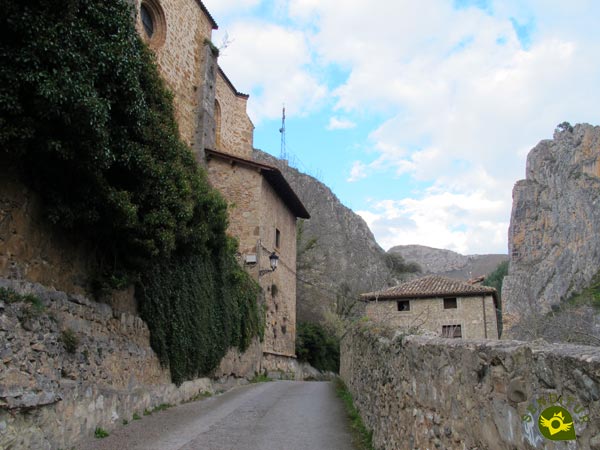
We enter the town without deviating at any time, leaving behind the many streets that come out in our path. A last steep slope brings us closer to the church of the Caves Neighborhood, which we are walking through.

This same street we entered is the one that takes us to the Mother of God Bridge, where the GR 93 and the Route of Three Villas also ends, with which we have been sharing the itinerary for some time now.

After crossing the bridge, on our left we will already see the road by which we started this beautiful itinerary.

When we reach the height of the road, we will only have to approach the next parking of Anguiano (4h 40min), where we begin this Route of Rocks.
The different itinerary options offered by the route allow us to adapt the distance to our liking.
As it coincides with several hiking routes, belonging to the Routes between Beech Forests, we have the possibility of adapting the itinerary to our preferences and characteristics, thus varying the time and the final distance. If we follow the proposed route and approach the Nuño Cave and the Chestnut Tree of La Nisia we will only have to add to the total time about 10 minutes extra, of course, plus the time we spend on your visit.
Although this route is appropriate to travel throughout the year, except for occasional days of bad weather or snow, it is in these two seasons where we can enjoy the colorful splendor of the mountains and forests that runs.
This route combines tracks in good condition with more or less marked trails and sections where the good grip and stability provided by our shoes will be appreciated. For the rest, we must have a water bottle and food in our backpacks, together with clothes that protect us from the weather at any time of the year. Of course, the camera will be a good companion as well as the walking sticks, which in this type of routes provide stability and relieve the legs of work. Consult our list of material and equipment for hiking. Read more.
Physical
The distance added to the slope that we have to face, with some hard ramps, is what partly increases the level of difficulty of this trekking route through Anguiano. It is very important to get hydrated and to eat properly in order to prevent the route from taking more than the expected toll. The many options that we have when we find more routes in our journey, allow each person to adapt the route to their taste and capabilities, increasing or decreasing the demand and difficulty of the route.
Severity of the environment
We will have to assume some sections of a certain entity, especially for people who are not used to this type of terrain. The route crosses rocky sides, where although with due caution we should not have any problem, we are required to be attentive. Mud and rain will be our main enemies, as they will leave us with quite slippery areas which, depending on the direction in which we are going, can create difficulties. Pay close attention both to the Nuño Cave and to its surroundings, even though it may not seem like it, we are in quite steep terrain with steep drops, so keeping to the route and maintaining a reasonable distance from the cuts will avoid unnecessary frights.
Orientation
Generally well signposted, it is the many coincidences with other routes that can generate more doubts about why we should continue. The area where it will be most difficult to follow the route is the section from Nuño Cave to the junction with the GR, since the path is not defined and we will have to follow it from one sign to another at our discretion, so it may be easier to skip one. It is also important to carry a GPS or a map to help us if necessary.
| 1-Anguiano | 0:00h | 644m | 0Km | 30T 519251 4678576 |
| 2-Hermitage of La Magdalena | 0:25h | 790m | 1.6Km | 30T 520060 4677666 |
| 3-La Tejera | 1:20h | 1004m | 4Km | 30T 521450 4678007 |
| 4-Anguiano | 2:30h | 660m | 9Km | 30T 519548 4679416 |
| 5-Nuño Cave | 2:55h | 651m | 10.4Km | 30T 519241 4679808 |
| 6-Marimatea Ravine | 3:45h | 799m | 12.8Km | 30T 518738 4679432 |
| 7-Ayanatón Meadows | 4:05h | 867m | 13.4Km | 30T 518518 4679467 |
| 8-Chestnut tree of the Nisia | 4:25h | 759m | 14.6Km | 30T 518220 4678957 |
| 9-Anguiano | 4:40h | 644m | 15.8Km | 30T 519251 4678576 |
Coordinates UTM Datum WGS84

![]() Slope: 1766m
Slope: 1766m
![]() Slope +: 833m
Slope +: 833m
![]() Slope -: 833m
Slope -: 833m
![]() Maximum altitude: 1004m
Maximum altitude: 1004m
![]() Minimum altitude: 644m
Minimum altitude: 644m

This sketch of the route is not made to scale nor does it contain all the information relating to the area, it is merely indicative.
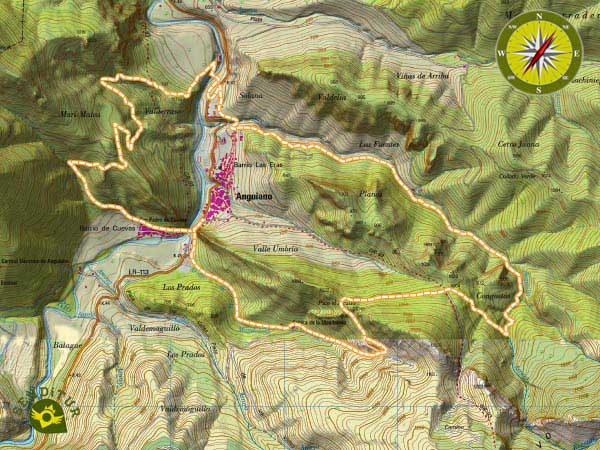
This schematic with the path is approximate and has been created from the derived cartographic base © Instituto Geográfico Nacional "Cuadrante 241-1 y 241-3, 1:25.000"
Senditur has manipulated the tracks to correct the aberrant points that may exist, caused by problems with the reception of the GPS signal. In any case the tracks are always approximate. SENDITUR encourages you to use the new technologies within your reach, using them as support and consultation in your activity, not basing the realization and orientation of the same only and exclusively on them, since they may see their functioning altered by very diverse causes, not functioning correctly and their indications may not be precise.
Ruta que permite dar una vuelta por todo el entorno del pueblo de Anguiano...tiene preciosas vistas, combina pista con senda y aventureras cuevas. Además se puede hacer por tramos...primero por una lado del Najerílla y en otro momento el otro lado.
Solo puede hacer la mitad de la ruta y me gusto bastante, estoy deseando volver para terminar la parte que me falta.
¿Did you know that...
The Mother of God Bridge is suspended more than 29 meters above the Najerilla River. Built back in the 18th century, the walls that flanked it were not nearly as high as they are today, hence the people who crossed it exclaimed, Mother of God, and this, it is said, is the origin of its name.
Don't miss out...
The Chestnut tree of the Nisia or the Cave of Nuño, in both cases the detour we have to face increases practically no distance or effort to this route and in exchange we will be able to know so much a singular and old chestnut tree, as a legendary cave with spectacular views.
.jpg)
From the commitment of SENDITUR with Nature and the respect to the balance of the environment, SENDITUR urges you to travel in a responsible way, with low environmental impact and respecting at all times the Natural, Cultural and Social environment wherever you go.
Besides sharing with all of us your experience on the route we would be grateful if you could write to us to inform us of any erroneous or outdated information you may have found, or simply to let us know what you think at Thank you.
This route has been carried out in the field by SENDITUR on 12-04-2016. The route may vary greatly depending on the time of year, weather conditions and terrain, as well as the actions of third parties and the evolution suffered in the natural environment where it is located. All opinions, advice and/or assessments made by SENDITUR in their descriptions are for guidance only and are subject to and/or refer to the specific conditions of the specific day of the route, referring to that specific day, taken from trained people, with the appropriate experience and with a high level of physical and technical preparation as a reference, as well as correctly equipped.
All the times are approximate and take an orientative character, the stops have not been taken into account, no matter how small they are. All the information related to the route, texts, images, videos, maps, diagrams, tracks, towns, and places of tourist interest are published as a guide, and may not coincide with the current state of each place. Before undertaking any activity, assess your technical knowledge, your physical condition, find out about the weather and the variations that the route may undergo, equip yourself correctly, be prudent and responsible at all times, and do not exceed your capabilities. SENDITUR is not responsible for any misuse or inappropriate use of the comprehensive guides of its routes and/or publications as well as its electronic guides, nor for any variations in their descriptions for the aforementioned reasons, and recommends that everyone be responsible and prudent in carrying out the activity. We also encourage you to read books and specialised guides to complement the information described above.
Continue watching …